

Eating Better - Blog - Why consumers need help to shift to sustainable diets. Consumers are in an unprecedented dilemma over food.

On the one hand, they have never had it so good. Supermarkets have spread worldwide and are awash with food. On the other hand the rate that over-consumption of food is growing globally is unsustainable – and its effect on the environment are already being felt. La saison serait le premier critère d'achat des fruits et légumes selon une étude - ATABULA. Snacking et Restauration rapide : un marché en plein essor [Dossier] Le boom des compléments alimentaires bio. What to Make of Those Animal-Welfare Labels on Meat and Eggs. Les métamorphoses du consommateur-producteur-distributeur. Multicultural Consumers: Refreshing the Retail Landscape.
Over 120 million strong in the U.S., multicultural Americans are a large, young and growing segment.
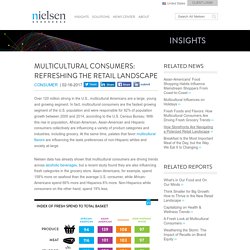
In fact, multicultural consumers are the fastest growing segment of the U.S. population and were responsible for 92% of population growth between 2000 and 2014, according to the U.S. Census Bureau. With this rise in population, African-American, Asian-American and Hispanic consumers collectively are influencing a variety of product categories and industries, including grocery. At the same time, palates that favor multicultural flavors are influencing the taste preferences of non-Hispanic whites and society at-large. Nielsen data has already shown that multicultural consumers are driving trends across alcoholic beverages, but a recent study found they are also influencing fresh categories in the grocery store. Les modestes effets de l'étiquetage nutritionnel de Leclerc.
Rappels/alimentaires: CLCV veut un site internet. Consommateur/Choix : L’origine l’emporte sur le prix. Consommation : Les producteurs attendus sur internet. Perspectives d'achat en ligne pour 2017 : enquête CSA/Fevad. Africa and Middle East love sweet bakes, but want sugar reduction. African men and women enjoy sweet baked goods consumed throughout the day, between meals, at work, on the go, for school, as meal replacements and for “me times”, says Dupont.

“Growth markets in the Middle East and Africa are of particular interest to the sweet bakery industry,” said Lena Hamman, bakery marketing manager at DuPont Nutrition & Health. According to Innova Market Insights, 57% of bakery launches in those countries are in the sweet segment, strongly led by biscuits and cookies. A sweet survey. EU seafood survey: 28,000 polled. Italians most adventurous. These are just some of the results of a pan-EU survey conducted by Eurobarometer on behalf of the Directorate-General for Maritime Affairs and Fisheries (DG MARE).

Aiming to shed light on Europeans’ preferences for aquaculture and fishery products – with the ultimate objective of gaining a deeper understanding of the internal market so that operators can be more competitive – researchers interviewed a total of 27,818 citizens face-to-face in their homes and in their native language. DG MARE said it will use the information, collected using a socially and demographically representative sample of respondents, to support new strategies to stimulate growth, strengthen economic activities in the internal market and create jobs.
‘Low-content’ food labels are ‘misleading’ for consumers, US study claims. Variations in nutrient density suggested that the food or beverage did not necessarily offer better overall nutritional profiles or better profiles for the nutrient, as set out by the claim.
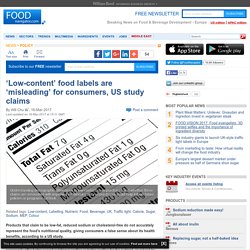
The researchers went as far as to say that in some cases, these claims could mislead consumers about the overall nutritional quality of the food. “As consumers try to navigate an ever-increasing number of food and beverage choices, being able to parse what these claims mean will become even more critical,” the study stated. “These findings show how the lack of consistency about what these statements mean can lead content claims to be used to sell generally unhealthy foods as a healthier alternative.”
Will concern for what pigs eat impact sales? Dive Brief: A Cargill study, reported this month in Food Manufacturing, said that at least 32% of millennials care about the diets pigs are fed, and 42% of them feel it isn't particularly healthy.This is a humane issue for consumers and a practical one for Cargill, which spends considerable time and resources to ensure what it feeds swine not only improves their growth rates but also considers the likes of gut health.While almost all of the people spoken to for the survey eat pork products, there was a lot they didn't know about the way it was raised.
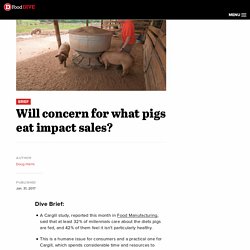
Only 10% had an accurate idea of how much feed a pig needs to get to market weight, and more than a third of millennials think it currently takes more land and water to raise pigs today than 50 years ago. (It actually takes less.) Dive Insight: Are complex textures a new snack trend? Dive Brief: General Mills, Inc. has released Nature Valley Granola Cups, a new snack the company developed in response to rising consumer interest in snacks with multiple textures, according to Food Business News.Roy Bechtold, a senior scientist for the company, wrote in the company's Taste of General Mills blog that people are interested in dual or multiple textures like the ones found in the new product, which combines creamy nut butter, crunchy whole grain oats and nuts.Nature Valley Granola Cups’s development took approximately a year and a half to go from idea to store.

Dive Insight: Study: 24% of snack food eating happens during meals. Dive Brief: Almost a quarter of all snack food eating (24%) now occurs during main meals, up from 21% five years ago, according to a study from The NPD Group.Snacking is more popular with millennials and members of Generation Z, who tend to be more concerned with their health.
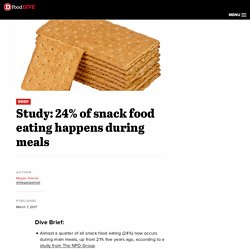
Fresh fruit and yogurt — both seen as healthy options — are the two most popular meal time snacks.The young adults who are snacking more now are expected to continue this behavior as they age, with per capita snacking at meal times expected to increase by 12%. Consumer perception and behaviour regarding sustainable protein consumption: A systematic review. The review addressed three questions: 1) Are consumers aware that meat consumption has a large environmental impact?
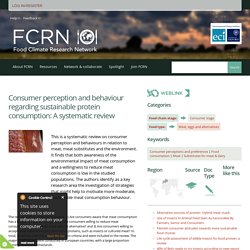
2) Are consumers willing to reduce meat consumption or substitute meat with an alternative? And 3) Are consumers willing to accept meat substitutes and alternative proteins, such as insects or cultured meat? Poulet, petit-dej paléo et soupe : les plats les plus « tendances » à travers le monde selon les petite épingles de Pinterest – ATABULA. Consumers' perceptions of food risks: A snapshot of the Italian Triveneto area. Abstract This study investigated the food risk perceptions of people living in the Triveneto area (Northeast Italy), a territory characterized by a particular interest in the production of quality foodstuffs, to determine what aspects people associate with food risk and to understand what beliefs underlie these perceptions.

Four focus groups were conducted in the major towns of the target area (N = 45). Allemagne : les consommateurs de plus en plus actifs. Most skeptical of GM food information from industry leaders. The food industry is big business – and many Americans cast a skeptical eye toward the information it provides to the public about genetically modified (GM) foods. A new Pew Research Center survey finds most Americans have limited trust in information from food industry leaders.
Only one-in-ten (10%) say they trust food industry leaders a lot to provide full and accurate information on the health effects of GM foods and another 32% say they trust information from food industry leaders some. A majority (57%) do not trust information from food industry leaders too much or at all. And people who are deeply concerned about the issue of GM foods are especially distrustful of information from the food industry. Some 16% of Americans say they care a great deal about the issue of GM foods. Protéines durables : qu'en pensent les consommateurs d'Europe du Nord ? West versus East: Measuring the development of Chinese wine preferences. Ethics rather than fancy apps turn millennials on: Survey. Shoppers aged 18 to 34 years old are more than happy to ditch their favourite brands at the drop of a hat, with 61% having switched in the past 12 months, pollsters at YouGov found. The research, commissioned by supply chain management firm GT Nexus, also revealed that the category they’re most likely to ‘brand hop’ in is food and drink (47%).
UK consumers are the most likely to ditch their favourite food and drink brands (56%), followed by those in the US (49%), France (45%) and Germany (40%). Poor quality and lack of availability were the top two reasons for disloyalty, cited by 41% and 36% of respondents respectively. Ethical food and drink worth over €10.5 billion in the UK. The standout performer was the Freedom Food certification scheme for meat, with sales rocketing 28.6% to £1.57 billion (€1.83 billion). The 25% hike in licensing fees could in part account for the impressive figures. Still, the fact rates can be increased so significantly in one go “is tribute [the scheme’s] popularity and significance in the UK food market”, noted the authors of the Ethical Consumer Markets Report 2016. Demand for sustainable fish also continues to rise, with sales up 15.2% to £507 million.
The market for vegetarian products grew by 6.3% to £710 million (€830 million), whilst organic continued its resurgence with sales up 4.5% to a shade over £1.74 billion (€2.03 billion). Construire un monde numérique dans lequel les consommateurs peuvent avoir confiance. Qui est prêt à payer davantage pour un produit vert ? - Ministère de l'Environnement, de l'Energie et de la Mer. A concept mapping study on organic food consumers in Shanghai, China. Shrinking the food-print: A qualitative study into consumer perceptions, experiences and attitudes towards healthy and environmentally friendly food behaviours.
Ingredient Inspectors: Consumers Embrace Dietary Diligence. Gone are the days of being blissfully ignorant about what’s in the food we eat. In fact, consumers around the world are increasingly focused on clean eating and the benefits of eating more healthfully, with 70% of global respondents in Nielsen’s Global Health and Ingredient-Sentiment Survey saying they actively make dietary choices to help prevent health conditions such as obesity, diabetes, high cholesterol and hypertension. “Consumers want to eat more healthfully, but they can’t do it alone,” said Andrew Mandzy, Director of Strategic Health and Wellness Insights, Nielsen. “They need help from food manufacturers to offer products that are formulated with good-for-you ingredients. They need help from retailers to stock shelves with right-priced healthful assortment.
And they need help from the medical community to provide proper guidance on what and how much to eat in order to maintain a healthy lifestyle.” Serving Up Simple: Global Consumers Want Transparency in Ingredients. Weighing Consumers' Growing Appetite for 'Clean' Meat Labeling. Not So Sweet: Sugar Consumption in Decline due to Growing Consumer Health Concerns. 9 Français sur 10 aimeraient être livrés quotidiennement en produits frais à domicile.
Profil des consommateurs bio, cohorte NutriNet-Santé. Food for seniors: The million dollar opportunity that industry is in denial about. Ecolabel market to grow by 66%, and will become more powerful than regulation, say Danish researchers. Summary of consumption changes of meat and dairy products in China over 22 years. Food Foundation report on vegetable consumption in the UK. Publication de la DGE sur la part de la consommation collaborative dans les achats et revenus des ménages en 2014. La consommation collaborative représentait moins de 10 % des achats et des revenus des ménages en 2014. Finlande : De plus en plus de consommateurs achètent les alternatives végétariennes. Appetite, Special Issue: Consumer behaviour in a changing world. Les végétaliens fous de junk-food ! All4Pack : Les attentes des Européens sur l'emballage. Better Buying Lab Aims to Accelerate Demand for Sustainable Food.
Choice of supermarket in Ireland is not driven by low prices. Growing Grocery Online: Innovation in Digital Commerce for CPG. Pays Basque : étude de la consommation des produits alimentaires locaux. Conditions de vie-Société - En 2015, la hausse du pouvoir d'achat dope la consommation des ménages. Euromonitor functional beverage trends.
Eating whole insects preferred to bug-snack mixes: Study. Social media could get Brits to eat their fruit and veg – Euromonitor. Baby food and probiotics driving expectations for a €1.7bn colostrum market within the decade. More pictures, less numbers: FSA advises on healthy food labelling. A decline of Western Fast Food consumption in China? Global fish consumption per capita hits record high according to new FAO report. British Journal of Nutrition - Typology of eaters based on conventional and organic food consumption: results from the NutriNet-Santé cohort study. Consumer trust in the Australian food system – The everyday erosive impact of food labelling. Alimentation Bio : profil et typologie des consommateurs.
Reeling it in: global sustainable seafood market hits $11.5bn. La consommation alternative, entre critique et récupération. Pour près de 75% des consommateurs dans le monde, le pays d'origine d'une marque est un des critères d'achat les plus importants. Lettuce Show You the Way: Consumer Demand for Salad Kits Is Increasing. Des prix élevés à Paris, en Corse et en outre-mer. De Paris à Pékin, les consommateurs plébiscitent les marques locales, Conso - Distribution. Foodtail : verre ou assiette ? Nos études : Consommation Responsable. Enquête sur les pratiques et les habitudes de consommation des fruits et légumes. What is the New Consumerism? RICHFIELDS : Une plateforme de données pour en savoir plus sur les choix alimentaires des consommateurs. Online grocery shopping accelerated by young male Australian shoppers: Nielsen. Le marché du sans gluten poursuit son ascension. Fair Trade Logo Boosts Consumer’s willingness to pay.
Top 15 des catégories de produits bio... - Produits Biologiques. Les pratiques de consommation alternatives arrivent à maturité. Etude prospective de la DGE sur la consommation collaborative. Viande/Monde : la consommation va continuer à progresser (chercheurs) Demand for natural colours is going global, finds 5000-strong survey. Marketing to millennials: Mass-produced food with a personal touch. What do protected origin labels mean to consumers? Flavour tourism: On the trail of Europe's future trends. Food labelling more of a concern for consumers. Front-of-pack labels boost purchase intent – regardless of nutrition.
Norwegians increasingly sceptical about organic. Clean-label growth. Bigger portions and packages lead to higher food and drink consumption: Cochrane review. Global packaged foods market to surpass $3T by 2020: report. The Global Resurgence of Street Food. Les Français hésitent à consommer des produits provenant d’animaux nourris avec des farines d’insectes. Suède : Ventes bio record. En direct du Forum Vitagora : étude exclusive d’IPSOS et révélations sur la tendance alimentaire du prêt-à-consommer en France… Les Français sont-ils en train de réinventer le s. Ce que veulent les consommateurs. Expertise de Philippe Moati au Forum Vitagora 2015. How people defend eating meat. La viande biologique a conquis 16% des Français. Un mythe moderne: le pouvoir du consommateur. Achats de fruits et légumes frais par les ménages français. Consommation des produits de la pêche et de l'aqculture 2014.